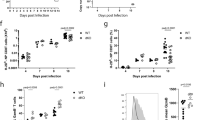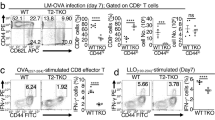Abstract
In addition to ligation of the T cell antigen receptor (TCR), activation of the CD28 coreceptor by the costimulatory molecule B7 is required for induction of the transcription factor NF-κB and robust T cell activation, although the contribution of CD28 to this process remains incompletely understood. We show here that phosphoinositide-dependent kinase 1 (PDK1) is essential for integrating the TCR and CD28 signals. After we deleted PDK1 from T cells, TCR-CD28 signals were unable to induce activation of NF-κB or phosphorylation of protein kinase C-θ, although T cell survival and pathways dependent on the kinases p38 and Jnk or the transcription factor NFAT were unaffected. CD28 facilitated NF-κB activation by regulating recruitment and phosphorylation of PDK1, which are necessary for efficient binding of PDK1 to protein kinase C-θ and the adaptor CARMA1 and thus for NF-κB induction.
This is a preview of subscription content, access via your institution
Access options
Subscribe to this journal
Receive 12 print issues and online access
$209.00 per year
only $17.42 per issue
Buy this article
- Purchase on Springer Link
- Instant access to full article PDF
Prices may be subject to local taxes which are calculated during checkout






Similar content being viewed by others
References
Rothenberg, E.V. & Taghon, T. Molecular genetics of T cell development. Annu. Rev. Immunol. 23, 601–649 (2005).
Alegre, M.L., Frauwirth, K.A. & Thompson, C.B. T-cell regulation by CD28 and CTLA-4. Nat. Rev. Immunol. 1, 220–228 (2001).
Kane, L.P., Lin, J. & Weiss, A. It's all Rel-ative: NF-κB and CD28 costimulation of T-cell activation. Trends Immunol. 23, 413–420 (2002).
Diehn, M. et al. Genomic expression programs and the integration of the CD28 costimulatory signal in T cell activation. Proc. Natl. Acad. Sci. USA 99, 11796–11801 (2002).
Rincon, M. & Flavell, R.A. AP-1 transcriptional activity requires both T-cell receptor-mediated and co-stimulatory signals in primary T lymphocytes. EMBO J. 13, 4370–4381 (1994).
Shahinian, A. et al. Differential T cell costimulatory requirements in CD28-deficient mice. Science 261, 609–612 (1993).
Green, J.M. et al. Absence of B7-dependent responses in CD28-deficient mice. Immunity 1, 501–508 (1994).
Pages, F. et al. Binding of phosphatidylinositol-3-OH kinase to CD28 is required for T-cell signalling. Nature 369, 327–329 (1994).
Mora, A., Komander, D., van Aalten, D.M. & Alessi, D.R. PDK1, the master regulator of AGC kinase signal transduction. Semin. Cell Dev. Biol. 15, 161–170 (2004).
Engelman, J.A., Luo, J. & Cantley, L.C. The evolution of phosphatidylinositol 3-kinases as regulators of growth and metabolism. Nat. Rev. Genet. 7, 606–619 (2006).
Casamayor, A., Morrice, N.A. & Alessi, D.R. Phosphorylation of Ser-241 is essential for the activity of 3-phosphoinositide-dependent protein kinase-1: identification of five sites of phosphorylation in vivo. Biochem. J. 342, 287–292 (1999).
Taniyama, Y. et al. Pyk2- and Src-dependent tyrosine phosphorylation of PDK1 regulates focal adhesions. Mol. Cell. Biol. 23, 8019–8029 (2003).
Scheid, M.P., Parsons, M. & Woodgett, J.R. Phosphoinositide-dependent phosphorylation of PDK1 regulates nuclear translocation. Mol. Cell. Biol. 25, 2347–2363 (2005).
Lawlor, M.A. et al. Essential role of PDK1 in regulating cell size and development in mice. EMBO J. 21, 3728–3738 (2002).
Hinton, H.J., Alessi, D.R. & Cantrell, D.A. The serine kinase phosphoinositide-dependent kinase 1 (PDK1) regulates T cell development. Nat. Immunol. 5, 539–545 (2004).
Lee, K.Y., D'Acquisto, F., Hayden, M.S., Shim, J.H. & Ghosh, S. PDK1 nucleates T cell receptor-induced signaling complex for NF-κB activation. Science 308, 114–118 (2005).
Wan, Y.Y., Chi, H., Xie, M., Schneider, M.D. & Flavell, R.A. The kinase TAK1 integrates antigen and cytokine receptor signaling for T cell development, survival and function. Nat. Immunol. 7, 851–858 (2006).
Weil, R. & Israel, A. Deciphering the pathway from the TCR to NF-κB. Cell Death Differ. 13, 826–833 (2006).
Sun, Z. et al. PKC-θ is required for TCR-induced NF-κB activation in mature but not immature T lymphocytes. Nature 404, 402–407 (2000).
Huppa, J.B. & Davis, M.M. T-cell-antigen recognition and the immunological synapse. Nat. Rev. Immunol. 3, 973–983 (2003).
Alessi, D.R. et al. 3-Phosphoinositide-dependent protein kinase-1 (PDK1): structural and functional homology with the Drosophila DSTPK61 kinase. Curr. Biol. 7, 776–789 (1997).
Gao, X. & Harris, T.K. Role of the PH domain in regulating in vitro autophosphorylation events required for reconstitution of PDK1 catalytic activity. Bioorg. Chem. 34, 200–223 (2006).
Sanchez-Lockhart, M. et al. Cutting edge: CD28-mediated transcriptional and posttranscriptional regulation of IL-2 expression are controlled through different signaling pathways. J. Immunol. 173, 7120–7124 (2004).
Schulze-Luehrmann, J. & Ghosh, S. Antigen-receptor signaling to nuclear factor kappa B. Immunity 25, 701–715 (2006).
Wang, D. et al. CD3/CD28 costimulation-induced NF-κB activation is mediated by recruitment of protein kinase C-θ, Bcl10, and IκB kinase β to the immunological synapse through CARMA1. Mol. Cell. Biol. 24, 164–171 (2004).
Matsumoto, R. et al. Phosphorylation of CARMA1 plays a critical role in T cell receptor-mediated NF-κB activation. Immunity 23, 575–585 (2005).
Sommer, K. et al. Phosphorylation of the CARMA1 linker controls NF-κB activation. Immunity 23, 561–574 (2005).
Juntilla, M.M. & Koretzky, G.A. Critical roles of the PI3K/Akt signaling pathway in T cell development. Immunol. Lett. 116, 104–110 (2008).
Juntilla, M.M., Wofford, J.A., Birnbaum, M.J., Rathmell, J.C. & Koretzky, G.A. Akt1 and Akt2 are required for αβ thymocyte survival and differentiation. Proc. Natl. Acad. Sci. USA 104, 12105–12110 (2007).
Hashimoto, N. et al. Ablation of PDK1 in pancreatic beta cells induces diabetes as a result of loss of beta cell mass. Nat. Genet. 38, 589–593 (2006).
Lee, P.P. et al. A critical role for Dnmt1 and DNA methylation in T cell development, function, and survival. Immunity 15, 763–774 (2001).
Nakagawa, M. et al. MALT1 contains nuclear export signals and regulates cytoplasmic localization of BCL10. Blood 106, 4210–4216 (2005).
Acknowledgements
We thank Y. Wan (Yale University) for help with the Cre transgenic mice, C. Wilson (University of Washington) for the CD4-Cre mice, T.K. Harris (University of Miami) for antibody to Thr513-phosphorylated PDK1 and D.R. Littman (New York University) for the Prkcq knockout mice. Supported by the National Institutes of Health (R01-AI59440).
Author information
Authors and Affiliations
Contributions
S.-G.P. designed and performed experiments, analyzed and interpreted data and wrote the paper; J.S.-L. performed and assisted with experiments; M.S.H. interpreted data and wrote the paper; N.H., W.O. and M.K. generated the Pdk1 conditional knockout mice; S.G. conceived the study, interpreted data and wrote the paper.
Corresponding author
Ethics declarations
Competing interests
The authors declare no competing financial interests.
Supplementary information
Supplementary Text and Figures
Supplementary Figures 1–15 (PDF 8934 kb)
Rights and permissions
About this article
Cite this article
Park, SG., Schulze-Luehrman, J., Hayden, M. et al. The kinase PDK1 integrates T cell antigen receptor and CD28 coreceptor signaling to induce NF-κB and activate T cells. Nat Immunol 10, 158–166 (2009). https://doi.org/10.1038/ni.1687
Received:
Accepted:
Published:
Issue Date:
DOI: https://doi.org/10.1038/ni.1687
This article is cited by
-
Iguratimod suppresses Tfh cell differentiation in primary Sjögren’s syndrome patients through inhibiting Akt/mTOR/STAT3 signaling
Arthritis Research & Therapy (2023)
-
Transcriptional regulation of Notch1 by nuclear factor-κB during T cell activation
Scientific Reports (2023)
-
FAM167A is a key molecule to induce BCR-ABL-independent TKI resistance in CML via noncanonical NF-κB signaling activation
Journal of Experimental & Clinical Cancer Research (2022)
-
ZIP8 exacerbates collagen-induced arthritis by increasing pathogenic T cell responses
Experimental & Molecular Medicine (2021)
-
Signaling networks in immunometabolism
Cell Research (2020)



